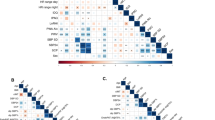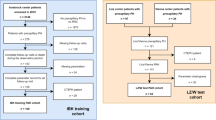Abstract
We sought to evaluate whether unbiased machine learning of dense phenotypic data (“phenomapping”) could identify distinct hypertension subgroups that are associated with the myocardial substrate (i.e., abnormal cardiac mechanics) for heart failure with preserved ejection fraction (HFpEF). In the HyperGEN study, a population- and family-based study of hypertension, we studied 1273 hypertensive patients utilizing clinical, laboratory, and conventional echocardiographic phenotyping of the study participants. We used machine learning analysis of 47 continuous phenotypic variables to identify mutually exclusive groups constituting a novel classification of hypertension. The phenomapping analysis classified study participants into 2 distinct groups that differed markedly in clinical characteristics, cardiac structure/function, and indices of cardiac mechanics (e.g., phenogroup #2 had a decreased absolute longitudinal strain [12.8 ± 4.1 vs. 14.6 ± 3.5%] even after adjustment for traditional comorbidities [p < 0.001]). The 2 hypertension phenogroups may represent distinct subtypes that may benefit from targeted therapies for the prevention of HFpEF.


Similar content being viewed by others
Abbreviations
- BIC:
-
Bayesian information criterion
- BMI:
-
Body mass index
- CAD:
-
Coronary artery disease
- CV:
-
Cardiovascular
- DBP:
-
Diastolic blood pressure
- CS:
-
Circumferential strain
- LS:
-
Longitudinal strain
- RS:
-
Radial strain
- HyperGEN:
-
Hypertension Genetic Epidemiology Network
- LV:
-
Left ventricular
- SBP:
-
Systolic blood pressure
References
Oktay, A. A., & Shah, S. J. (2014). Current perspectives on systemic hypertension in heart failure with preserved ejection fraction. Current Cardiology Reports, 16(12), 545.
Egan, B. M., Zhao, Y., & Axon, R. N. (2010). US trends in prevalence, awareness, treatment, and control of hypertension, 1988-2008. JAMA, 303(20), 2043–2050.
Citterio, L., Lanzani, C., & Manunta, P. (2011). Polymorphisms, hypertension and thiazide diuretics. Pharmacogenomics, 12(11), 1587–1604.
Cuspidi, C., Rescaldani, M., Sala, C., Negri, F., Grassi, G., & Mancia, G. (2012). Prevalence of electrocardiographic left ventricular hypertrophy in human hypertension: an updated review. Journal of Hypertension, 30(11), 2066–2073.
Cuspidi, C., Sala, C., Negri, F., Mancia, G., Morganti, A., & Italian Society of H. (2012). Prevalence of left-ventricular hypertrophy in hypertension: an updated review of echocardiographic studies. Journal of Human Hypertension, 26(6), 343–349.
Dahlof, B., Devereux, R. B., Kjeldsen, S. E., Julius, S., Beevers, G., de Faire, U., et al. (2002). Cardiovascular morbidity and mortality in the Losartan Intervention For Endpoint reduction in hypertension study (LIFE): a randomised trial against atenolol. Lancet, 359(9311), 995–1003.
Sagie, A., Larson, M. G., & Levy, D. (1993). The natural history of borderline isolated systolic hypertension. The New England Journal of Medicine, 329(26), 1912–1917.
Suonsyrja, T., Hannila-Handelberg, T., Paavonen, K. J., Miettinen, H. E., Donner, K., Strandberg, T., et al. (2008). Laboratory tests as predictors of the antihypertensive effects of amlodipine, bisoprolol, hydrochlorothiazide and losartan in men: results from the randomized, double-blind, crossover GENRES Study. Journal of Hypertension, 26(6), 1250–1256.
Perneger, T. V. (1993). Projections of hypertension-related renal disease in middle-aged residents of the United States. JAMA, 269(10), 1272.
Andreadis, E. A., Tsourous, G. I., Tzavara, C. K., Georgiopoulos, D. X., Katsanou, P. M., Marakomichelakis, G. E., et al. (2007). Metabolic syndrome and incident cardiovascular morbidity and mortality in a Mediterranean hypertensive population. American Journal of Hypertension, 20(5), 558–564.
Ceravolo, R., Maio, R., Cuda, G., Scozzafava, A., Sciacqua, A., Vatrano, M., et al. (2003). Relation of fasting insulin related to insertion/deletion polymorphism of angiotensin-converting enzyme-gene and cardiac mass in never-treated patients with systemic hypertension. American Journal of Cardiology, 92(10), 1234–1237.
Conen, D., Zeller, A., Pfisterer, M., & Martina, B. (2006). Usefulness of B-type natriuretic peptide and C-reactive protein in predicting the presence or absence of left ventricular hypertrophy in patients with systemic hypertension. American Journal of Cardiology, 97(2), 249–252.
Greenberg, J. (2006). Are blood pressure predictors of cardiovascular disease mortality different for prehypertensives than for hypertensives? American Journal of Hypertension, 19(5), 454–461.
Hiltunen, T. P., & Kontula, K. (2012). Clinical and molecular approaches to individualize antihypertensive drug therapy. Annals of Medicine, 44(Suppl 1), S23–S29.
Hiltunen, T. P., Suonsyrja, T., Hannila-Handelberg, T., Paavonen, K. J., Miettinen, H. E., Strandberg, T., et al. (2007). Predictors of antihypertensive drug responses: initial data from a placebo-controlled, randomized, cross-over study with four antihypertensive drugs (The GENRES Study). American Journal of Hypertension, 20(3), 311–318.
Matsui, Y., Eguchi, K., Shibasaki, S., Ishikawa, J., Shimada, K., & Kario, K. (2010). Morning hypertension assessed by home monitoring is a strong predictor of concentric left ventricular hypertrophy in patients with untreated hypertension. Journal of Clinical Hypertension (Greenwich, Conn.), 12(10), 776–783.
Nakamura, M., Tanaka, F., Yonezawa, S., Satou, K., Nagano, M., & Hiramori, K. (2003). The limited value of plasma B-type natriuretic peptide for screening for left ventricular hypertrophy among hypertensive patients. American Journal of Hypertension, 16(12), 1025–1029.
Perez-Lloret, S., Toblli, J. E., Cardinali, D. P., Malateste, J. C., & Milei, J. (2008). Nocturnal hypertension defined by fixed cut-off limits is a better predictor of left ventricular hypertrophy than non-dipping. International Journal of Cardiology, 127(3), 387–389.
Phillips, R. A. (1998). Relation among left ventricular mass, insulin resistance, and blood pressure in nonobese subjects. Journal of Clinical Endocrinology & Metabolism, 83(12), 4284–4288.
Schillaci, G., Pirro, M., Vaudo, G., Gemelli, F., Marchesi, S., Porcellati, C., et al. (2004). Prognostic value of the metabolic syndrome in essential hypertension. Journal of the American College of Cardiology, 43(10), 1817–1822.
Vasan, R. S., Benjamin, E. J., Larson, M. G., Leip, E. P., Wang, T. J., Wilson, P. W., et al. (2002). Plasma natriuretic peptides for community screening for left ventricular hypertrophy and systolic dysfunction: the Framingham Heart Study. JAMA, 288(10), 1252–1259.
International Consortium for Blood Pressure Genome-Wide Association, S, Ehret, G. B., Munroe, P. B., Rice, K. M., Bochud, M., Johnson, A. D., et al. (2011). Genetic variants in novel pathways influence blood pressure and cardiovascular disease risk. Nature, 478(7367), 103–109.
James, P. A., Oparil, S., Carter, B. L., Cushman, W. C., Dennison-Himmelfarb, C., Handler, J., et al. (2014). 2014 evidence-based guideline for the management of high blood pressure in adults: report from the panel members appointed to the Eighth Joint National Committee (JNC 8). JAMA, 311(5), 507–520.
Shah, S. J., Katz, D. H., Selvaraj, S., Burke, M. A., Yancy, C. W., Georghiade, M., et al. (2015). Phenomapping for Novel classification of heart failure with preserved ejection fraction. Circulation, 131(3), 269–279.
Kao, D. P., Stevens, L. M., Hinterberg, M. A., & Gorg, C. (2017). Phenotype-specific association of single-nucleotide polymorphisms with heart failure and preserved ejection fraction: a genome-wide association analysis of the cardiovascular health study. Journal of Cardiovascular Translational Research. Epub ahead of print.
Luo, Y., Ahmad, F. S., & Shah, S. J. (2017). Tensor factorization for precision medicine in heart failure with preserved ejection fraction. Journal of Cardiovascular Translational Research. Epub ahead of print.
Williams, R. R., Rao, D. C., Ellison, R. C., Arnett, D. K., Heiss, G., Oberman, A., et al. (2000). NHLBI family blood pressure program: methodology and recruitment in the HyperGEN network. Hypertension genetic epidemiology network. Annals of Epidemiology, 10(6), 389–400.
Devereux, R. B., Roman, M. J., de Simone, G., O’Grady, M. J., Paranicas, M., Yeh, J. L., et al. (1997). Relations of left ventricular mass to demographic and hemodynamic variables in American Indians: the Strong Heart Study. Circulation, 96(5), 1416–1423.
Palmieri, V., Dahlof, B., DeQuattro, V., Sharpe, N., Bella, J. N., de Simone, G., et al. (1999). Reliability of echocardiographic assessment of left ventricular structure and function: the PRESERVE study. Prospective Randomized Study Evaluating Regression of Ventricular Enlargement. Journal of the American College of Cardiology, 34(5), 1625–1632.
Sahn, D. J., DeMaria, A., Kisslo, J., & Weyman, A. (1978). Recommendations regarding quantitation in M-mode echocardiography: results of a survey of echocardiographic measurements. Circulation, 58(6), 1072–1083.
Lang, R. M., Bierig, M., Devereux, R. B., Flachskampf, F. A., Foster, E., Pellikka, P. A., et al. (2005). Recommendations for chamber quantification: a report from the American Society of Echocardiography’s Guidelines and Standards Committee and the Chamber Quantification Writing Group, developed in conjunction with the European Association of Echocardiography, a branch of the European Society of Cardiology. Journal of the American Society of Echocardiography, 18(12), 1440–1463.
Galema, T. W., Geleijnse, M. L., Yap, S. C., van Domburg, R. T., Biagini, E., Vletter, W. B., et al. (2008). Assessment of left ventricular ejection fraction after myocardial infarction using contrast echocardiography. European Journal of Echocardiography, 9(2), 250–254.
Peteiro, J., Pinon, P., Perez, R., Monserrat, L., Perez, D., & Castro-Beiras, A. (2007). Comparison of 2- and 3-dimensional exercise echocardiography for the detection of coronary artery disease. Journal of the American Society of Echocardiography, 20(8), 959–967.
Aguilar, F. G., Selvaraj, S., Martinez, E. E., Katz, D. H., Beussink, L., Kim, K. Y., et al. (2016). Archeological echocardiography: digitization and speckle tracking analysis of archival echocardiograms in the HyperGEN study. Echocardiography, 33(3), 386–397.
Hastie, T., Tibshirani, R., & Friedman, J. (2009). Unsupervised learning: hierarchical clustering. In T. Hastie, R. Tibshirani, & J. Friedman (Eds.), The elements of statistical learning (2nd ed., pp. 520–528). New York: Springer.
Hahsler, M., Hornik, K., & Buchta, C. (2008). Getting things in order: an introduction to the R package seriation. Journal of Statistical Software, 25(3), 1–34.
Fraley, C., & Raftery, A. E. (2002). Model-based clustering, discriminant analysis, and density estimation. Journal of the American Statistical Association, 97, 611–631.
Hinton, G. E., & Salakhutdinov, R. R. (2006). Reducing the dimensionality of data with neural networks. Science, 313(5786), 504–507.
Coffman, T. M. (2011). Under pressure: the search for the essential mechanisms of hypertension. Nature Medicine, 17(11), 1402–1409.
Zile, M. R., & Baicu, C. F. (2013). Biomarkers of diastolic dysfunction and myocardial fibrosis: application to heart failure with a preserved ejection fraction. Journal of Cardiovascular Translational Research, 6(4), 501–515.
Kriegel, A. J., Gartz, M., Afzal, M. Z., de Lange, W. J., Ralphe, J. C., & Strande, J. L. (2016). Molecular approaches in HFpEF: MicroRNAs and iPSC-derived cardiomyocytes. Journal of Cardiovascular Translational Research. Epub ahead of print.
Author information
Authors and Affiliations
Corresponding author
Ethics declarations
Conflicts of Interest
The authors declare that they have no conflict of interest.
Informed Consent
Informed consent was obtained from all individual participants included in the study.
Funding Sources
The HyperGEN cardiac mechanics ancillary study was funded by the National Institutes of Health (NIH; R01 HL107577 to S.J.S.). The HyperGEN echocardiography ancillary study was funded by the National Institutes of Health (R01 HL55673 to D.K.A.). The HyperGEN parent study was funded by cooperative agreements (U10) with the National Heart, Lung, and Blood Institute: HL54471, HL54472, HL54473, HL54495, HL54496, HL54497, HL54509, HL54515. Dr. Shah was also supported by NIH HL127028 and American Heart Association grants #16SFRN28780016 and 15CVGPSD27260148). Dr. Katz was supported by an Alpha Omega Alpha Carolyn L. Kuckein Research Fellowship.
Ethical Approval
All procedures performed in studies involving human participants were in accordance with the ethical standards of the institutional and/or national research committee and with the 1964 Helsinki declaration and its later amendments or comparable ethical standards.
Disclosures
None.
Additional information
Associate Editor Paul J. R. Barton oversaw the review of this article
Electronic Supplementary Material
Below is the link to the electronic supplementary material.
ESM 1
(DOC 167 kb)
Rights and permissions
About this article
Cite this article
Katz, D.H., Deo, R.C., Aguilar, F.G. et al. Phenomapping for the Identification of Hypertensive Patients with the Myocardial Substrate for Heart Failure with Preserved Ejection Fraction. J. of Cardiovasc. Trans. Res. 10, 275–284 (2017). https://doi.org/10.1007/s12265-017-9739-z
Received:
Accepted:
Published:
Issue Date:
DOI: https://doi.org/10.1007/s12265-017-9739-z




